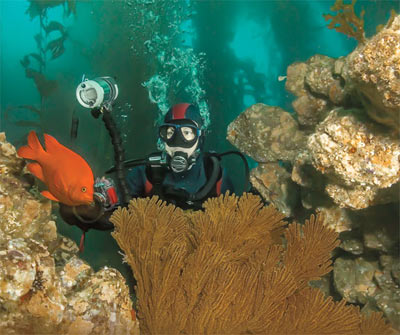Being lost at sea as a diver has once again been thrown into the debate pot regarding diving safety. In late April, on a dive trip to a Southern California oil rig, a diver surfaced far from the charter boat and, unable to return to the boat, could not get the attention of the divemaster with a simple whistle. His absence went unnoticed until reaching the next dive destination. Bottom line: The diver drifted in the open ocean until being picked up by a Boy Scout troop out on a sailing cruise.
Unfortunately, divers lost at sea will continue to be a topic of discussion through the summer, this time also amongst the general public. The release of the motion picture Open Water this August will put another spin on the subject. Open Water is loosely based on a true story of two divers accidentally left behind in the open ocean leaving them to fend for themselves against the elements, including hungry sharks.
It is a weak film, but because it is based on a true story that, yes, indeed happened, it will frighten both the general public and divers. Divers have been lost at sea, sometimes through their own fault, sometimes the fault of the boat, but usually a combination of both. Divers have also been attacked by sharks, but as divers we know that is an extreme rarity, and we are more at risk of life and limb on the freeway.
Bringing your risk to an absolute minimum, to the point of negligible, is actually quite easy. First, carry the right gear. At minimum, you need to have with you a “safety sausage” and an air horn. A safety sausage inflates tall so you can be seen from a long way off, even in choppy seas. A safety sausage is now required personal dive equipment on many dive boats, particularly if current diving or drift-diving, if anticipated. In addition, the sausage, properly rigged, can be used for an open water safety stop or used in an area with high boat traffic to signal oncoming boats that a diver is ascending or present on the surface.
An air horn emits a piercing sound that can be heard up to a mile away. The air horn is also an excellent way to surface signal the boat in a hurry in case of an emergency. Whistles, even storm whistles, while good, are just not loud enough. Air horns are also now being required on some advanced dive trips.
There is additional equipment you should seriously consider carrying in your BC pocket. All are small and generally inexpensive. A signal mirror is compact, cheap and highly effective but only on sunny days. A chemical light (cylume) will give the diver visibility at night. Even better might be a compact flashing signal strobe which can be seen on a cloudy day as well as at night.
For more risky situations, you could consider two additional pieces of gear. Waterproof hand-held flares are available, allowing a diver to be seen from miles away. A few dive stores carry them, but you can also check with boating supply outlets. There a two major problems with flares, however. You cannot take them on airplanes and after 20 dives or so they should be replaced.
And for the ultimate emergency locator device, a waterproof Mini-B EPIRB (Emergency Position Indicating Radio Beacon) may be necessary. On a recent live-aboard trip to the Galapagos (very remote and LOTS of current) the vessel required a safety sausage, air horn, strobe, and strongly suggested an EPIRB. With an EPIRB you can be located quickly and accurately both by satellite and surface search parties. The Mini-B is compact (a bit bigger than a pack of cards) and relatively inexpensive (under $200).
Not being left behind is more than just the right gear. More than anything it has to do with diving procedures. Dive with a buddy. Always be present for the roll call on the boat and never answer for somebody else. Ask that the divemaster take roll call, not just count tanks. Make a point to check yourself on and off the boat (the divemaster will remember you are emphatic about procedure). Always enter the water where the divemaster is checking people off. If you enter the water without the divemaster knowing, you may get skipped on check in. When diving from an anchored boat, use good navigation skills to return to the boat and use smart current diving skills, always heading upcurrent on the first portion of the dive. In situations where you are diving from your own boat or kayak or diving from the beach, make sure somebody on shore knows where you’ll be diving and when you’re expected to return. If diving from your own boat, if at all possible, leave somebody onboard the boat that can operate the boat in the event of an emergency.
Like most of diving, you simply need to use common sense and have a couple of backup systems to be safe.










